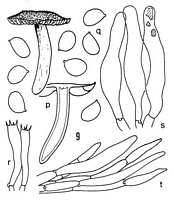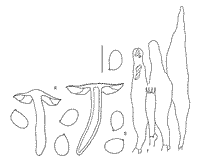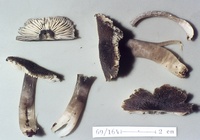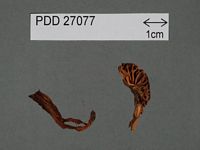|
 Neohygrocybe squarrosa Neohygrocybe squarrosa
SynonymsHygrocybe squarrosa
BiostatusPresent in region - Indigenous. Endemic
Images (click to enlarge)
Caption: Neohygrocybe squarrosa Hk. (type): p. carpophores. - q. spores. - r. basidia. - s. pleurocystidia. - t. cuticle | 
Caption: Fig. 50 Neohygrocybe squarrosa Horak (R-T: PDD 27077,
type): R. basidiomes. S. spores. T. basidium and pleurocystidia. | 
Caption: ZT69-164 , Holotype
Owner: E. Horak: © Creative Commons Attribution-Noncommercial 3.0 New Zealand | 
Caption: Dried type specimen
Owner: Herb PDD | |
Article: Horak, E. (1990). Monograph of the New Zealand Hygrophoraceae (Agaricales). New Zealand Journal of Botany 28(3): 255-306 (http://www.rsnz.org/publish/abstracts.php).
Description: Pileus -45 mm, conico-convex later becoming expanded to plane; pale brown-grey
to argillaceous-grey; densely covered with concolorous small to coarse, squarrose
scales, radially splitting towards margin; dry, not hygrophanous, non-striate
margin. - Lamellae 14-20 (1 -3) moderately distant, emarginate-adnate to decurrent
with short tooth, ventricose; whitish turning pale grey, not reddening on bruising
or on exposure, edges concolorous, entire.-Stipe 30-60 x 7-9 mm, cylindrical,
equal or attenuated towards base; grey at apex, paler or whitish towards base;
dry, with conspicuous longitudinal fibrils, hollow, fragile, single to caespitose.
- Context grey, unchanging. - Odour and taste not distinctive. - Chemical reactions
on pileus: KOH, HCI - negative.
Spores 6.5-7.5 x 4.5-5.5 um, ovoid. - Basidia 30-38 x 7 um, 4-spored. - Pleurocystidia
70-95 x 14-18 um, fusoid to lageniform, membrane thin-walled, hyaline, occasionally
with strongly refractive granules in plasma, rare. -Pileipellis a trichoderm
of bundled, cylindrical hyphae (8-16 um diam.), terminal cells fusoid, encrusted
with brown pigment; clamp connections present (Pl. 1, Fig. 1).
Habitat: ECOLOGY: Rare; saprobic on soil among litter in, broadleaved-conifer forests.
March.
Distribution: DISTRIBUTION: NZ (STI).
Notes: Neohygrocybe squarrosa is readily recognised by the strongly squamulose
pileus, the grey-brown, hollow, brittle stipe and the conspicuous pleurocystidia
on the lamellae.
Article: Horak, E. (1973). Fungi Agaricini Novazelandiae I-V. Beihefte zur Nova Hedwigia 43: 200 p.
Description: Pileus 25-45 mm diam., conico-convex when young later becoming flat, plane, brownish grey to beige-grey, densely covered with small squarrose, concolorous scales, splitting radially, dry, estriate, not hygrophanous. Lamellae emarginate-adnate to decurrent with short tooth, whitish turning greyish, ventricose, moderately distant, gill edge concolorous, even. Stipe 30-60 x 7-9 mm, cylindrical, equal or attenuated towards the base, apex grey towards the base lighter or even whitish, dry, with conspicuous longitudinal fibrils, hollow, fragile, single or grown together. Context grey, unchanging after bruising. Taste and odor not distinctive. Chemical reactions on pileus: KOH, HCl - negative.
Spores 6.5-7.5 x 4.5-5.5 µm ovoid, smooth, inamyloid. Basidia 30-38 x 7 µ, 4-spored. Pleurocystidia 70-95 x 14 x 18 µm, fusoid to lageniform, membrane thin-walled, hyaline, occasionally with refractive granules in the plasma, rare.cuticle a trichoderm consisting of fasciculate, cylindric hyphae- (8-16 µdiam.), terminal cells fusoid, uplifted and forming the squamules, encrusted with brown pigment. Clamp connections present.
Habitat: On soil under Dacrydium, Podocarpus, Weinmannia, etc. New Zealand.
Notes: At first sight N. squarrosa could be taken as H. fornicatus (Fr.) but the N.Z. species is well characterized by its striking squamulose pileus, grey-brown stipe and presence of cystidia. The colour of the pileus never fades to whitish not even near the margin.
|